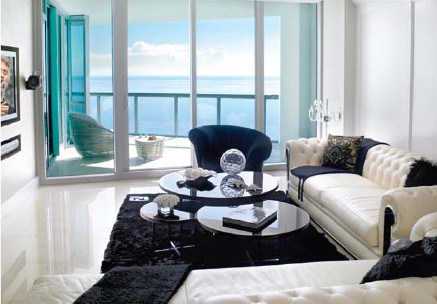How light can affect colour in a room
In discussing how color/colour works – and the influence of light with colour, I wanted to show you (as best I can) how some of all this looks in rooms with varied colour and light.
First; a primer on the light entering a room -
One of the first things a designer will do upon assessing a room, is to determine the quality of natural light. What direction does it come from? Is it filtered/diffused or is it direct and somewhat harsh? As you now know from my earlier post – colour is so controlled by light, it’s one of the things a designer will want to control. Ambient light can be a great thing, or it can be a troublesome thing!! Here are some basics, but remember these are only general guidelines!!
A room with full southern light.
Northern Light is usually a cool colour of light, and direct sunlight in your room might not be available (Unless you are are in the southern hemisphere, and then we need to think of your northern exposure as lot of direct light!) For those of us in the Americas, it’s good to use warm colors such as red, yellow or orange in our decor to compensate for the coolness of the light. Blues or greens will make the room appear even colder.
This room appears to already have had it’s morning sun via an eastern orientation I question the supplemental light planned for this room. Can you find the multiple sources of light added to the decor?
Southern Light is warmer and the “temperature” (or Kelvins) measures more of what we think of “sunny” light. These rooms will ask us for ways to control this light, and overall you can use darker colors in a room with a southern exposure. Blues and greens will “read” much warmer and “happier” in this kind of light. (see the Floridian rooms below!)
A room with warm sunny westerly light.
Eastern Light gives a room sunny mornings, but muted middays. The morning light is a cooler light compared to the afternoon light, and the afternoon offers no direct light. In this case, I really consider carefully the time(s) of day this room is really being used,but overall, use a mix of warms and cools to balance out the daylight.
Incomparable Geoffrey Bradfield's elegance. An example of northern light.
Western Light is by definition, afternoon light. Beyond capturing direct light in the afternoon, the light later in the day can read warmer than morning light. Golds and cream really blossom in this light so feel free to use neutrals in this room. If this room is really being used during the morning – I would need to consider how to augment with other lighting to bring the colour harmony to the room. I would tend not to use warm colors that will overpower the room in the afternoon.
Kelvins are used in the measurement of the “temperature” of light, and is a marker of the quality of light that I use most often.
above; note the use of grays here. This would seem to fly in the face of the advice above, but here is where the talented eye of an interior designer can make it work by “breaking the rules” so to speak.
I question the supplemental light planned for this room. Can you find the multiple sources of light added to the decor?
There are so many variables in working with light, as you now know – experience can help you know which side of the box to “push out” so to speak. The room above has a great deal of white, punched with strong colour. This is successful only because of the temperature (Kelvins) and the orientation of the light. The whites can appear warmer directly as result of that light. But – what about night-time, when this ambient light is not available? Interior lighting comes to the rescue with the very same principles in mind!
Now, let’s up the ante – and discuss how to bend the rules a little. We have noted already that with northern light, we might want to stay away from cooler colours, and keep to the red and gold colours to counteract the colour/kelvins of the light coming in. What if we wanted to actually USE that colour of light to our advantage?
Again, in the evening, it would be important to choose the interior lighting carefully. Would you place a flourescent bulb in this room? (it's a choice, for sure. Not mine, but a choice!)
I feel that this room shows a good “recipe” for proper lighting of a room. Many times, the actual lighting might be used a bit more creatively, and concealed in a more sophisticated way. As lighting fixtures are “jewelry” to a room, one should consider the look you want to achieve. Here below, notice the hanging light fixture that throws a lot of ambient light, the lamps with their shades give good general illumination, the wall sconces augment the work of the lamps, and places light at face level – eliminating shadows. Not easily seen here, are the overhead pinspots used creatively and up-lamps positioned for effect when needed. The overall balance of light is what is called for, and this room shows that well.
Notice the small lights within the bed for reading, the several different styles of lighting here. This is shown with some daylight coming in, but can you try to see how well you think this room is lit at night? Should a bedroom have overhead recessed lights?
Now, let’s talk about some rooms that have NO outside light at all, and rely just on interior lighting alone. Does this happen? Yes! Can it work? Yes!
I normally would never use this much overhead spot lighting, but we arranged the ultra small halogens in a grid like stars, onto a ceiling plane with Benjamin Moore's "Platinum Pearlescent" sprayed to automobile finish on the ceiling.
Take a look around your home. Do you feel you have the best colours working with the available daylight? Do you use the room during the day or the evening? Does your interior lighting plan contain enough sources of light, and is it balanced light? Most importantly – is it the right colour/temperature of light?








